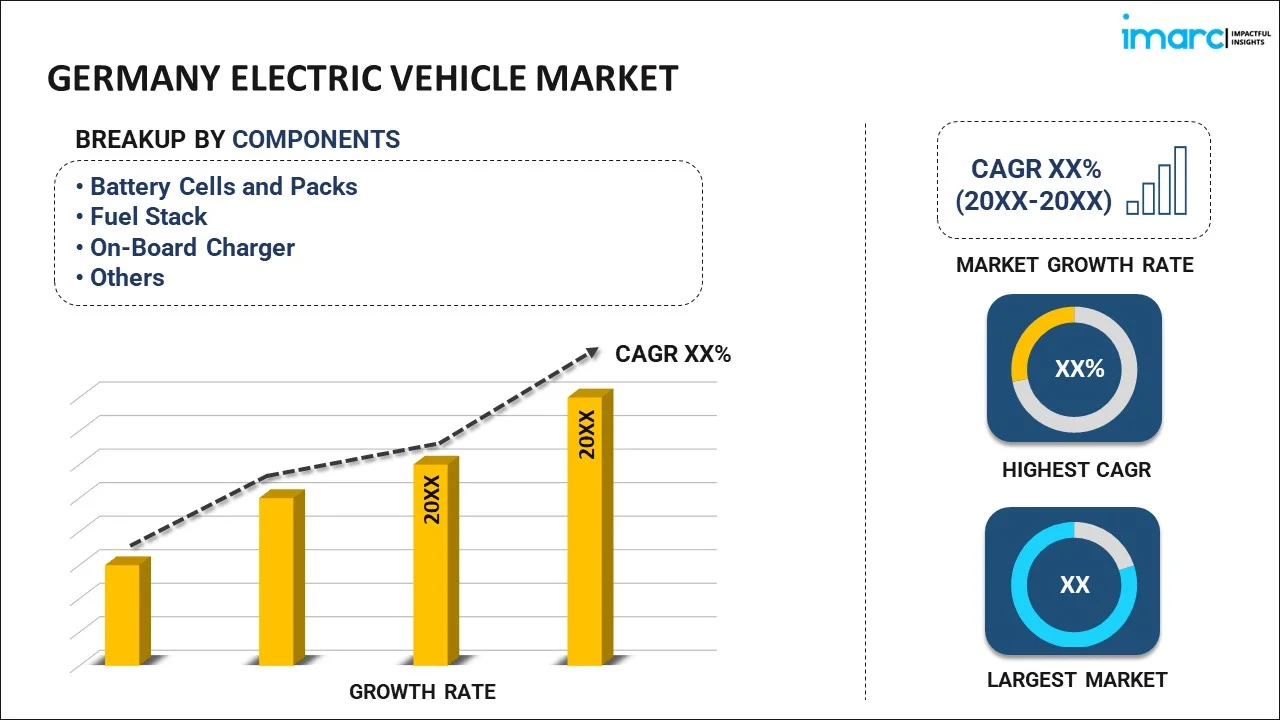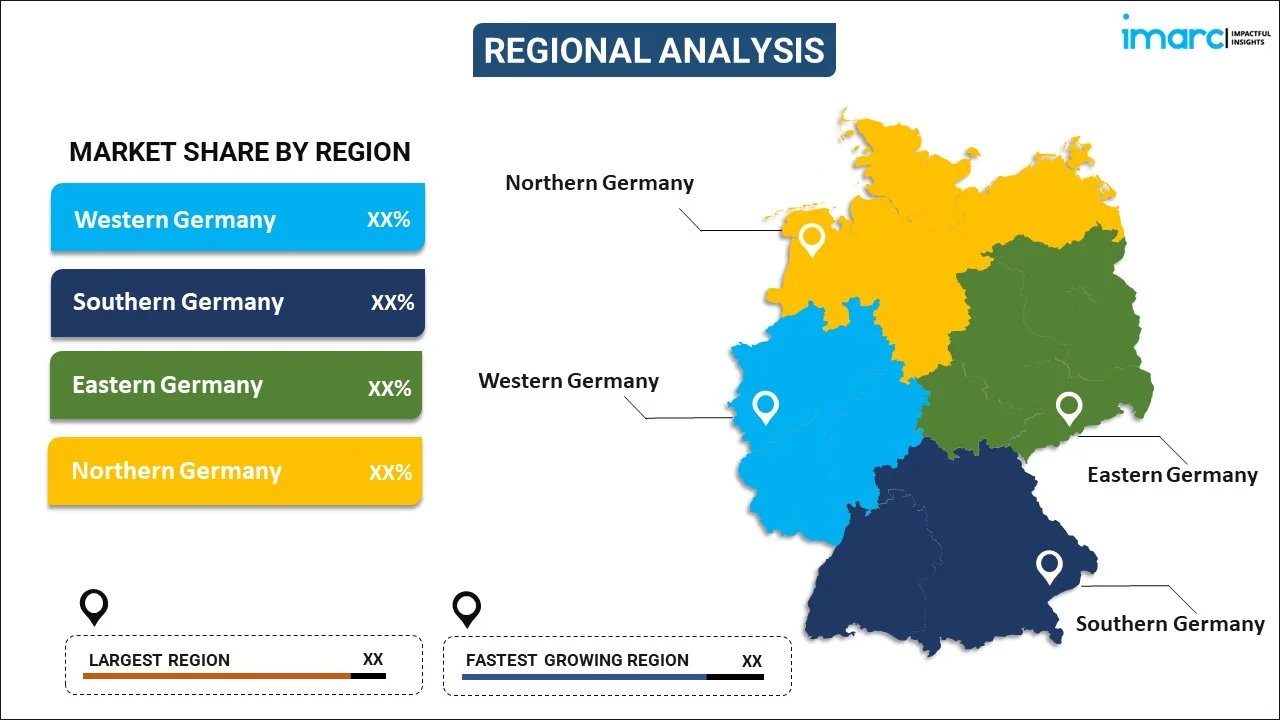
Germany Electric Vehicle Market Report by Component (Battery Cells and Packs, Fuel Stack, Onboard Chargers, Electric Motor, Brake, Wheel and Suspension, Body and Chassis, and Others), Propulsion Type (Battery Electric Vehicle (BEV), Fuel Cell Electric Vehicle (FCEV), Plug-In Hybrid Electric Vehicle (PHEV)), Vehicle Type (Passenger Vehicles, Commercial Vehicles, and Others), and Region 2025-2033
Germany Electric Vehicle Market Overview:
The Germany electric vehicle market size reached USD 33.9 Billion in 2024. Looking forward, IMARC Group expects the market to reach USD 228.5 Billion by 2033, exhibiting a growth rate (CAGR) of 23.62% during 2025-2033. Latest data shows strong growth in German electric car sales, with battery-electric vehicles (BEVs) accounting for a significant portion of registrations. Government incentives, robust infrastructure, and emission regulations continue to accelerate the German EV market, reinforcing sustainable mobility and increasing the overall Germany electric vehicle market share.
|
Report Attribute
|
Key Statistics
|
|---|---|
|
Base Year
|
2024
|
|
Forecast Years
|
2025-2033
|
|
Historical Years
|
2019-2024
|
|
Market Size in 2024
|
USD 33.9 Billion |
|
Market Forecast in 2033
|
USD 228.5 Billion |
| Market Growth Rate 2025-2033 | 23.62% |
Germany Electric Vehicle Market Trends:
Rising Fuel Costs and Supportive Government Policy
The rising expense of traditional fossil fuels such as gasoline and diesel, resulted in the adoption of Germany electric vehicles market. Moreover, customers are now looking into electric alternatives to reduce their reliance on gasoline and supporting environmental sustainability initiatives. Along with this, the rising expense of gasoline, and the appeal of German electric vehicle is due to the growing awareness of climate change and the need to minimize carbon footprints. Presently, the unleaded gasoline price reached EUR 1.87 per litre and diesel prices reached EUR 1.67 per litre in Germany. Additionally, it implemented ambitious strategies to address rising energy expenses, aiming to stabilize domestic demand and alleviate pressure on household and corporate finances from December 2021 to November 2022. As a result, this trend has accelerated customer desire for Germany EV market, spurring innovation and investment in electric mobility solutions by the automotive industry.
Increasing Electric Car Adoption
The rapid uptake of Germany electric vehicles market is indicative of a more widespread worldwide trend toward environmentally friendly transportation. Additionally, government incentives, growing environmental consciousness, and improvements in German EV market share technology such as longer battery life and better infrastructure for charging are contributing to the market growth. According to data from the Federal Motor Transport Authority (KBA), Germany witnessed a remarkable increase in e-car registrations by more than 37% compared to the first seven months of 2023 as compared to the same time the previous year. According to the KBA, there were about 269,000 new electric vehicles on the road, and battery-electric vehicles (BEVs) made up 16.4% of all new vehicle registrations. Thus, German EV market growth is supported by tax incentives, subsidies, and R&D spending, promising more prosperity and innovation across the region.
Company Fleet Electrification
Fleet electrification is becoming a decisive factor in the Germany EV Market as businesses transition to sustainable mobility. German corporates and logistics providers are increasingly adopting German electric vehicle fleets to meet emission reduction targets and cut operating costs. Leasing models, government fleet incentives, and total cost of ownership advantages are accelerating adoption among delivery companies, municipal services, and ride-sharing operators. Large-scale investments in charging depots and energy management systems also support this transition. The move to Germany electric vehicle market share growth is reinforced by European Union emission mandates, pushing companies to gradually phase out internal combustion fleets. Commercial adoption creates a ripple effect by normalizing electric transport across industries, boosting demand for both passenger and light commercial EVs. With automakers offering fleet-specific solutions and subsidies reducing upfront costs, company fleet electrification is emerging as a long-term growth pillar for the German EV market, reinforcing infrastructure expansion and accelerating the broader adoption of sustainable transportation.
Germany Electric Vehicle Market Segmentation:
IMARC Group provides an analysis of the key trends in each segment of the market, along with forecasts at the country level for 2025-2033. Our report has categorized the market based on component, propulsion type and vehicle type.
Component Insights:

To get more information on this market, Request Sample
- Battery Cells and Packs
- Fuel Stack
- On-Board Charger
- Electric Motor
- Brake, Wheel and Suspension
- Body and Chassis
- Others
The report has provided a detailed breakup and analysis of the market based on the component. This includes battery cells and packs, fuel stack, onboard chargers, electric motor, brake, wheel and suspension, body and chassis, and others.
Propulsion Type Insights:
- Battery Electric Vehicle (BEV)
- Fuel Cell Electric Vehicle (FCEV)
- Plug-In Hybrid Electric Vehicle (PHEV)
The report has provided a detailed breakup and analysis of the market based on the propulsion type. This includes battery electric vehicle (BEV), fuel cell electric vehicle (FCEV) and plug-in hybrid electric vehicle (PHEV).
Vehicle Type Insights:
- Passenger Vehicles
- Commercial Vehicles
- Others
A detailed breakup and analysis of the market based on the vehicle type have also been provided in the report. This includes passenger vehicles, commercial vehicles, and others.
Regional Insights:

- Western Germany
- Southern Germany
- Eastern Germany
- Northern Germany
The report has also provided a comprehensive analysis of all the major regional markets, which include Western Germany, Southern Germany, Eastern Germany, and Northern Germany.
German EV Companies:
The market research report has also provided a comprehensive analysis of the competitive landscape. Competitive analysis such as market structure, key player positioning, top winning strategies, competitive dashboard, and company evaluation quadrant has been covered in the report. Also, detailed profiles of all major companies have been provided.
Germany Electric Vehicle Market News:
- April 2024: Mercedes-Benz launched the electric G 580 EQ model, equipped with advanced off-road features like G-Turn and G-Steering, combining rugged performance with sustainability. The launch reflected innovation in premium EV offerings.
- June 2024: Volkswagen announced expanded EV battery production in Salzgitter, Germany, under its PowerCo division, supporting European supply chain security and lowering battery costs for the Germany EV market.
- May 2025: Ford announced production of the electric Explorer SUV in its Cologne facility, reinforcing its European EV portfolio and tapping into the Germany electric vehicles market.
Germany Electric Vehicle Market Report Coverage:
| Report Features | Details |
|---|---|
| Base Year of the Analysis | 2024 |
| Historical Period | 2019-2024 |
| Forecast Period | 2025-2033 |
| Units | Billion USD |
| Scope of the Report | Exploration of Historical and Forecast Trends, Industry Catalysts and Challenges, Segment-Wise Historical and Predictive Market Assessment:
|
| Components Covered | Battery Cells and Packs, Fuel Stack, Onboard Chargers, Electric Motor, Brake, Wheel and Suspension, Body and Chassis, Others |
| Propulsion Types Covered | Battery Electric Vehicle (BEV), Fuel Cell Electric Vehicle (FCEV), Plug-In Hybrid Electric Vehicle (PHEV) |
| Vehicle Types Covered | Passenger Vehicles, Commercial Vehicles, Others |
| Regions Covered | Western Germany, Southern Germany, Eastern Germany, Northern Germany |
| Customization Scope | 10% Free Customization |
| Post-Sale Analyst Support | 10-12 Weeks |
| Delivery Format | PDF and Excel through Email (We can also provide the editable version of the report in PPT/Word format on special request) |
Key Benefits for Stakeholders:
- IMARC’s industry report offers a comprehensive quantitative analysis of various market segments, historical and current market trends, market forecasts, and dynamics of the Germany electric vehicle market from 2019-2033.
- The research report provides the latest information on the market drivers, challenges, and opportunities in the Germany electric vehicle market.
- Porter's five forces analysis assist stakeholders in assessing the impact of new entrants, competitive rivalry, supplier power, buyer power, and the threat of substitution. It helps stakeholders to analyze the level of competition within the Germany electric vehicle industry and its attractiveness.
- Competitive landscape allows stakeholders to understand their competitive environment and provides an insight into the current positions of key players in the market.
Key Questions Answered in This Report
The Germany electric vehicle market was valued at USD 33.9 Billion in 2024.
The Germany electric vehicle market is projected to exhibit a CAGR of 23.62% during 2025-2033, reaching USD 228.5 Billion by 2033.
Key factors include government incentives, charging infrastructure development, stringent emissions regulations, rising fuel prices, and technological advancements supporting environmentally friendly transport.
Need more help?
- Speak to our experienced analysts for insights on the current market scenarios.
- Include additional segments and countries to customize the report as per your requirement.
- Gain an unparalleled competitive advantage in your domain by understanding how to utilize the report and positively impacting your operations and revenue.
- For further assistance, please connect with our analysts.
 Request Customization
Request Customization
 Speak to an Analyst
Speak to an Analyst
 Request Brochure
Request Brochure
 Inquire Before Buying
Inquire Before Buying




.webp)




.webp)












